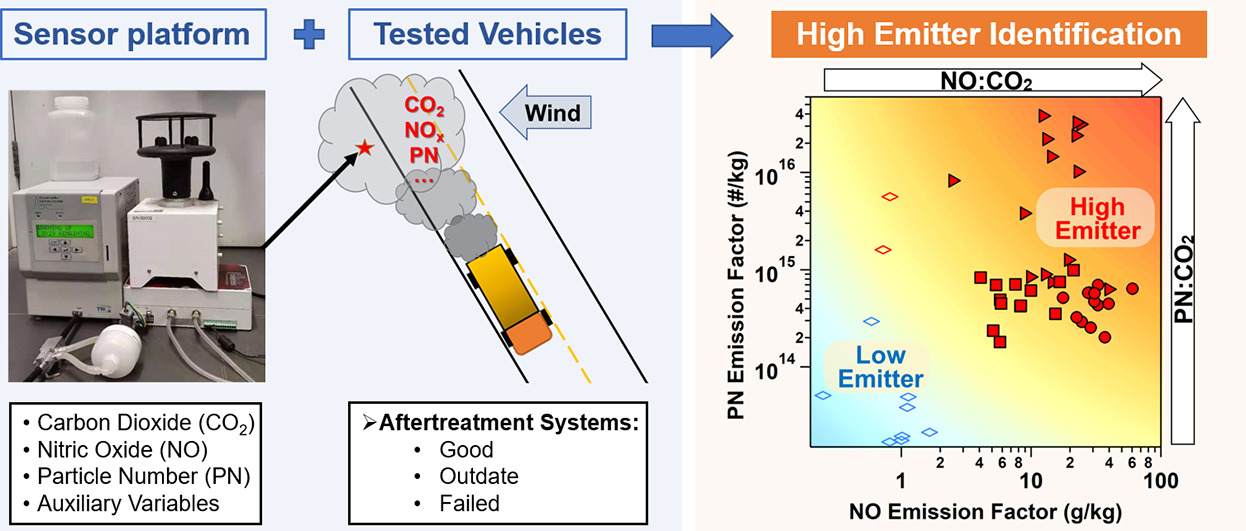Recently, Professor Jiang Jingkun and his team in the Division of Air Pollution and Its Control, School of Environment, Tsinghua University have made new progress in air pollution monitoring and sensing technology. Sensing technology has broad application prospects in air pollution prevention and control, such as monitoring sources of pollution and air quality. Given the breakthroughs made on the new sensing materials, the team has developed roadside sensor platforms to monitor emissions from on-road vehicles. By optimizing sensor network monitoring and big data analysis methods, the team has deployed severl sensing technology in identifying high emitters and monitoring urban air quality.
Identifying and monitoring high emitters is the key to targeted prevention and control of mobile source pollutions. The exhaust plumes of vehicles on roads disperse fast in the ambient air and the concentrations can be very low, setting high requirements for the response speed and accuracy of the sensor platform. Most of the existing technology for identifying high emitters relies on bulky instruments, which is costly, cumbersome, and challenging for massive deployment. To address the difficulties in identifying high emitters, the team has developed a portable roadside monitoring sensor platform and methods of big data analysis. The sensor platform is small, cost-effective, convenient, and suitable for massive networked deployment. The test results show that the sensor platform can identify high emitters quickly and accurately. Its identification results are consistent with those of more expensive instruments. The results were published in Science of The Total Environment under the title “Evaluation of a cost-effective roadside sensor platform for identifying high emitters”. The first author of the paper is Shen Yicheng, a postdoctoral researcher in the School of Environment, and the corresponding author is Jiang Jingkun. Collaborators of the paper include the Vehicle Emission Control Center of Chinese Research Academy of Environmental Sciences and the China Automotive Technology and Research Center Co., Ltd.

Roadside sensor platform and its identifications of high emitters
Data reliability in continuous monitoring is a major challenge for the application of sensing technology. The team has developed a method to control data quality including sensor pre-selection and calibration, and online calibration. The developed method, being successfully applied to air quality monitoring networks in Chengdu and Jining cities, can not only monitor the working condition of the sensors in the network, but also identify potential emitters quickly to make up for the inadequacy of existing air quality monitoring stations. These were published in Science of The Total Environment under the title “Improving data reliability: a quality control practice for low-cost PM2.5 sensor network”. The first author of the paper is Qiao Xiaohui, a direct doctoral student in the School of Environment, and the corresponding author is Jiang Jingkun.
One of the keys to develop sensing and monitoring technology is to improve the performance of sensing materials. In the early stage of the research, the team has cooperated with several groups and made a series of progresses in the R & D of new sensing materials and its performance improvement. A number of papers were also published in Advanced Materials, Small, Applied Catalysis B: Environmental, Environmental Science: Nano, and Journal of Hazardous Materials.
Link of the papers:
https://doi.org/10.1016/j.scitotenv.2021.151609
https://doi.org/10.1016/j.scitotenv.2021.146381
https://doi.org/10.1002/adma.202105276
https://doi.org/10.1016/j.jhazmat.2020.125034
https://doi.org/10.1002/smll.201902860
https://doi.org/10.1016/j.apcatb.2018.08.074
https://doi.org/10.1039/C8EN00498F





